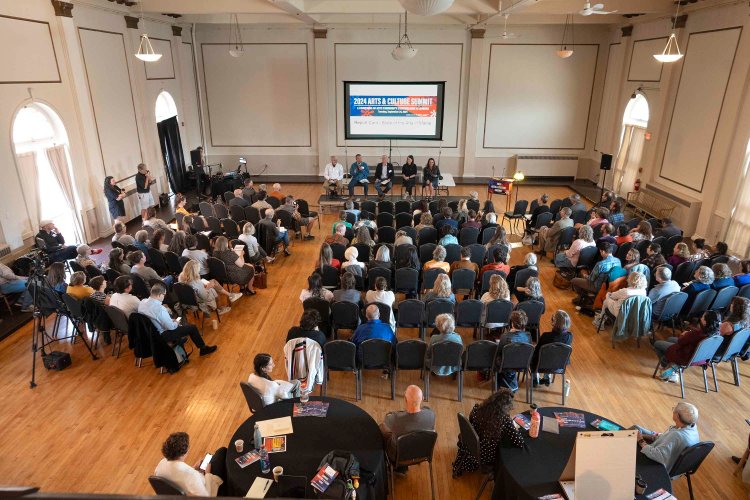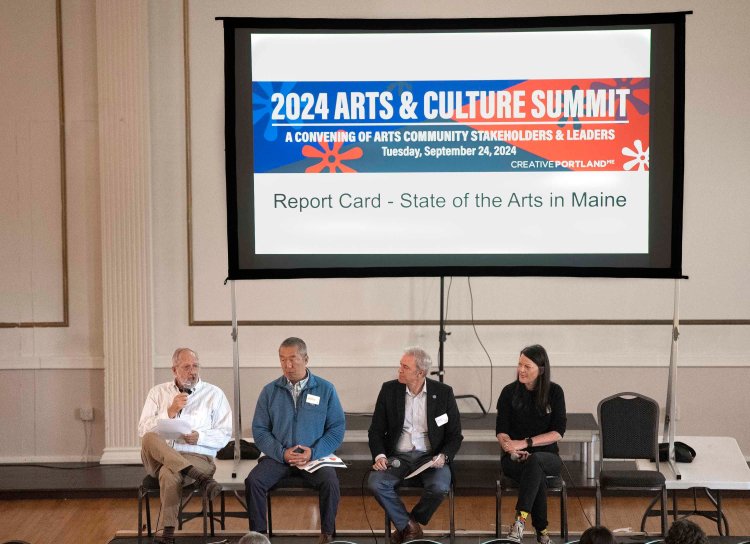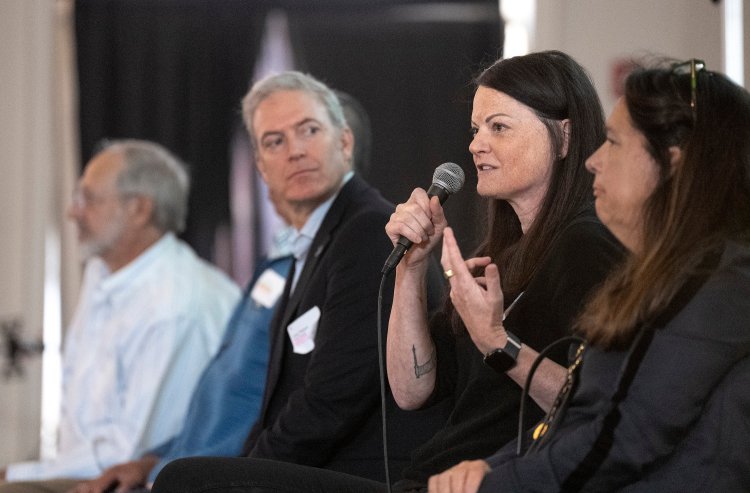

A panel discusses the state of the arts in Maine during Creative Portland’s 5th biennial Arts & Culture Summit at Mechanics’ Hall in Portland on Tuesday. Gregory Rec/Staff Photographer
In 2024, Maine ranked 35th in the nation for public funding for the arts.
That statistic might surprise those who associate the state with iconic paintings, historic artist colonies or performance venues that draw tourists from across the country. But it was top of mind for many guests and panelists at Creative Portland’s biennial Arts and Culture Summit on Tuesday at Mechanics’ Hall and Space in Portland.
All day, the conversation circled back again and again to the financial needs of a sector that was devastated by the COVID-19 pandemic and is still regaining its footing. Panels touched on how to secure more state funding for the arts, how to find rehearsal and studio space, how to deal with the rising cost of living in the state and how to reinvigorate business in the largest city’s arts district. Guests spanned government employees, nonprofit directors, individual artists and real estate developers.
Here are four takeaways from the all-day summit.
1. Maine ranks among nation’s lowest for public funding for arts
The Maine Arts Commission runs on a roughly $2 million budget. Only three states – Kansas, Wyoming and Idaho – have smaller budgets for their arts agencies.
Half of that money comes from the Maine Legislature, and half comes from the National Endowment for the Arts. The National Assembly for State Arts Agencies says that $1 million or so from the Legislature puts Maine at 35th in the country in fiscal year 2024 for public spending per capita on the arts.


Bob Keyes of the Maine Arts Commission speaks during a panel discussion on the state of the arts in Maine at Creative Portland’s 5th biennial Arts & Culture Summit at Mechanics’ Hall in Portland on Tuesday. Also on the panel were Tae Chong of the Maine State Chamber, Greg Watson of the City of Portland and Lauren Wayne of the State Theater. Gregory Rec/Staff Photographer
“One of our goals is to improve our per capita spending so that the arts in Maine receive the same level or more than some of the other legacy industries in our state,” said Bob Keyes, chairman of the Maine Arts Commission.
“We’ve always ranked in the lower half of the states despite an artistic legacy that is probably bigger than all but one or two other states in the country,” he added. “The level of funding has never equaled the level of artistic expression.”
2. Maine artists want a lobbyist in Augusta
But how to get more money from the state?
“We know the lobster industry has a lobbyist that is regularly in the State House advocating for that group,” Caroline Koelker, executive director of Opera Maine, said at one panel. “How can we as artists and arts organizations have that same presence?”
Others repeated that call throughout the day. Federal data shows that arts and culture is a $2.2 billion industry in Maine, and leaders at the summit said they should be considered in the same breath as the state’s other leading industries.
The answer might be coming from the Cultural Alliance of Maine, which formed in 2020 in response to the COVID-19 pandemic and the desire for cultural institutions to have more say in recovery funding and policy. Executive Director Mollie Cashwell said the alliance recently became a registered nonprofit, which will allow time for lobbying. She also said organizations can work together in multiple ways to increase visibility for their sector.
“Talking to other sectors like land trusts or outdoor recreation, they’re incredibly jealous of the arts and cultural sector because we have foot traffic, we have audiences, we have windows that face sidewalks that people walk past,” Cashwell said. “There is nothing stopping us from talking more about housing and raising visibility. There is nothing stopping us from using the platform that we have to raise more awareness of some of these issues.”
3. Lack of affordable housing a major problem for arts community
Nearly every panel touched on the high cost of living in Portland and in Maine. Lauren Wayne, general manager of the State Theatre, said 90% of employees there do not live in the city.
“They can’t afford it,” she said. “That’s the hospitality industry. When you’re going out to eat, when you’re going to a show, those people are the ones who are working every day to give us that experience and community. I would love to be able to see them enjoy that in the town that they work in.”


Lauren Wayne of the State Theatre speaks during a panel discussion about the state of the arts in Maine during Creative Portland’s 5th biennial Arts & Culture Summit at Mechanics’ Hall in Portland on Tuesday. Gregory Rec/Staff Photographer
The summit was located on both sides of Congress Street in the heart of the Arts District, and one panel focused on the effort to fill long vacancies in the neighborhood. Casey Oakes, associate director at Portland Ovations, said more affordable housing in the upper stories would help bring foot traffic back to those storefronts.
“With those people not downtown shopping and buying coffee and going out and getting day-to-day provisions, you’re seeing those businesses dry up and go away,” Oakes said. “So to me, the No. 1 thing is housing.”
In the audience was Chris White, who is involved with Maine Artists Cohousing. He said the group is trying to develop an affordable community where artists could live and work; its website says it is in the process of exploring ownership models, searching for properties and expanding its advisory board.
“This is a useless exercise unless we collectively do something about it,” he said.
4. Creative Portland’s app unites artists, groups, fans
The nonprofit has created a free app to promote the arts in the city. It offers a searchable list of art galleries, music venues and other destinations in Portland. Creative and cultural organizations can upload their events for people to browse and save. Visitors can use the app for self-guided tours of public art in Portland.
This fall, said Dinah Minot, executive director of Creative Portland, that group will use a grant to add to the app-augmented reality experiences for the Art Department, Maine Academy of Modern Music, Indigo Arts Alliance, Space and Loquat.
“It’s like a 24/7 art walk,” Minot said.

